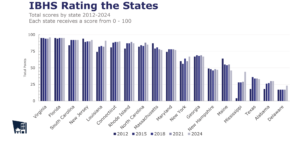American working culture is no stranger to the debate over the merits of a virtual workforce. Even those who focus on the pitfalls of remote working have to recognize the reality that technology is inevitably advancing—and that its ripple effects on business and commerce strain the existing proximity paradigm for hiring and retaining talent.
Executive Summary
Opinion: Reflecting on the efforts of the small Baltic nation Estonia to become a “digital republic,” encouraging remote businesses outside of its borders to put down “virtual roots” to fuel innovation there, Sharon Emek, CEO of WAHVE, the remote staffing firm for insurance and accounting, argues that technological advancement should drive American companies, including U.S. insurers, toward working dynamics that defy proximity, time zones, nationality and background.As the virtual world proliferates through technological advancement, location-independent working environments are often the deliverance that allows companies of all sizes to stay competitive.
If those realities aren’t convincing enough, maybe the remarkable story of a small Baltic nation, which is recounted in a December 2017 feature in The New Yorker titled “Estonia, the Digital Republic” and on the website e-Estonia.com, will hold sway. In Estonia, population 1.3 million, the government has completed a digitizing process that it characterizes as both “a cost-saving efficiency and an equalizing force” that “saves the country 2 percent of its GDP a year in salaries and expenses,” The New Yorker article says. This digitizing process makes every facet of Estonian citizens’ civil engagement digital and incredibly efficient—from voting to challenging parking tickets to registering a marriage license, even documenting health records and medical treatment.
How does this country’s technologically advanced, super-efficient digitized process relate to the working world?
Consider the impact of this streamlining, centralizing technology—”everything is digital and location-independent,” allowing Estonia to in effect run a “borderless country,” which encourages businesses to “put down virtual roots” in the country. Why welcome startups and other companies to capitalize on Estonia’s low tax rates for businesses and lenient regulations on tech research when these organizations exist physically outside of Estonia’s borders? The country’s deputy secretary for economic development asserts that innovation is imminent, and so it only makes sense to welcome and capitalize on it, saying, “If we close ourselves off, the innovation happens somewhere else,” according to The New Yorker article.
America seems mired in the debate over the pros and cons of remote working, flexible hours or any other deviation from the 9-to-5, office-based, 40-plus-hour work week. But the impact of technological advancement on our national and global economy is inarguable. It continues to drive us toward working dynamics that defy proximity, time zones, nationality and background. When we focus on the immediacy and impact of innovation, as the Estonian deputy secretary described it, why not face the music and delve in? We’re already well underway, with many American companies already using collaborative technologies like VPN, cloud drives and many other tools that connect us irrespective of our logistical circumstances and which enable virtual workforces to function. What’s holding us back?
Not only that, but collaborative technology often expedites efficiency, eliminating project bottlenecks and avoiding slumps in productivity that can arise between weekly one-on-one meetings or project update calls. It also makes vital information readily accessible 24/7, with tools like dashboards or cloud drives that show which projects employees are working on, tracks their progress and enables multiple employees to contribute as efficiently as possible on a given collaborative project.
As The New Yorker’s recent piece on Estonia, which it characterizes as “The Digital Republic,” so eloquently concludes, while “the history of nationhood is a history of boundaries marked on land, the old fatuities of the nation-state are showing signs of crisis.” As a result, more than ever “it is possible to imagine a future in which nationality is determined not so much by where you live as by what you log on to.”
I would venture to say that the history of the workplace is analogous—boundaries have been curtailed by proximity, and the existing paradigm exhibits signs of crisis. In response to this, I believe it is crucial to working America’s vitality in the digital age to strive for a future in which working is freed from geographic and temporal constraints and liberated to employ, retain and capitalize on the talent that is available to it through the virtual workforce.





















 P/C Insurance Execs, Underwriters Out of Sync on Advanced Tech
P/C Insurance Execs, Underwriters Out of Sync on Advanced Tech  Viewpoint: Risks for D&O Insurers Exploring the New Frontier of Gen AI
Viewpoint: Risks for D&O Insurers Exploring the New Frontier of Gen AI  Going, Going, Gone: ‘Disruption’ to Shrink Traditional Premiums for Auto
Going, Going, Gone: ‘Disruption’ to Shrink Traditional Premiums for Auto  The Supreme Court Just Complicated Employer Diversity Initiatives
The Supreme Court Just Complicated Employer Diversity Initiatives 
